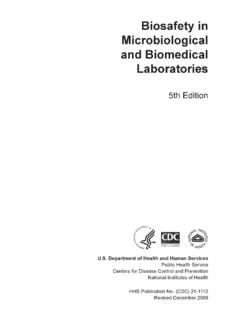Transcription of BIOSAFETY REGULATIONS - APAARI Community
1 BIOSAFETY REGULATIONS . OF. ASIA-PACIFIC COUNTRIES. Kavita Gupta, Karihaloo* and Khetarpal National Bureau of Plant Genetic Resources, New Delhi *Asia-Pacific Consortium on Agricultural Biotechnology, New Delhi Published by the Asia-Pacific Association of Agricultural Research Institutions Asia-Pacific Consortium on Agricultural Biotechnology and the Food and Agriculture Organization of the United Nations Citation: Gupta, K.; Karihaloo, and Khetarpal, 2008. BIOSAFETY REGULATIONS of Asia- Pacific Countries. Asia-Pacific Association of Agricultural Research Institutions, Bangkok; Asia- Pacific Consortium on Agricultural Biotechnology, New Delhi and Food and Agricultural Organization of the United Nations, Rome, P.
2 108 + i-x. The designations employed and the presentation of material in this publication do not imply the expression of any opinion whatsoever on the part of the Food and Agriculture Organization of the United Nations concerning the legal status on any country, territory, city or area or of its authorities, or concerning the delimitation of its frontiers or boundaries. The mention of specific companies or products of manufacturers, whether or not these have been patented, does not imply that these have been endorsed or recommended by the Food and Agriculture Organization of the United Nations in preference to others of a similar nature that are not mentioned.
3 The views expressed herein are those of the authors and do not necessarily represent those of the Food and Agriculture Organization of the United Nations. ISBN 978 92 5 105828 9. All rights reserved. Reproduction and dissemination of material in this information product for educational or other non-commercial purposes are authorized without any prior written permission from the copyright holders provided the source is fully acknowledged. Reproduction of material in this information product for resale or other commercial purposes is prohibited without written permission of the copyright holder.
4 Applications for such permission should be addressed to the Chief, Electronic Publishing Policy and Support Branch, Information Division, FAO, Viale delle Terme di Caracalla, 00153 Rome, Italy or by e-mail to FAO 2008. CONTENTS. Page Foreword v Preface vii Acronyms and Abbreviations ix 1 Status of Agricultural Biotechnology in Asia-Pacific 1. Farm Level Adoption and Approval of GM Crops 1. Research in GM Crops 2. Economic and Environmental Impact of GM Crops 5. Conclusion 6. 2 BIOSAFETY Issues in Agricultural Biotechnology 8. Potential Risk to the Environment and Human Health 8.
5 Effects on Fitness of the GM Plant per se 11. Addressing BIOSAFETY Issues 12. Conclusion 13. 3 International Agreements Related to BIOSAFETY 18. International Instruments on BIOSAFETY 18. Some Regional BIOSAFETY REGULATIONS 25. 4 BIOSAFETY REGULATIONS of Asia-Pacific Countries 28. Australia 29. Bangladesh 30. Bhutan 31. Cambodia 32. Chinese Taipei 34. DPR of Korea 34. Fiji 35. Hong Kong 35. India 35. Indonesia 38. Iran 39. Japan 40. Jordan 42. Kazakhastan 42. iv BIOSAFETY REGULATIONS of Asia-Pacific Countries Kyrgyz Republic 43. Lao People's Democratic Republic 44.
6 Lebanon 44. Malaysia 45. Maldives 46. Mongolia 46. Myanmar 46. Nepal 47. New Zealand 47. Niue 49. Pakistan 50. Papua New Guinea 51. People's Republic of China 52. Philippines 54. Republic of Korea 56. Samoa 58. Singapore 59. Sri Lanka 60. Syrian Arab Republic 61. Tajikistan 62. Thailand 63. Tonga 65. Vanuatu 65. Viet Nam 66. Yemen 66. 5 Overview of BIOSAFETY Regulatory Systems in Asia-Pacific 68. Provisions for Risk Assessment and Management 68. Monitoring and Inspection System 70. Public Information and Public Participation 72. Conclusion 72.
7 6 Regulatory Management The Way Ahead 73. Establishing National Regulatory Systems 73. Infrastructure and Human Resource Development 73. Reducing Compliance Cost 74. Regional Cooperation 75. Annexure I List of Participants in the APCoAB Workshop on BIOSAFETY REGULATIONS (2006) 77. II Status of the Asia-Pacific Countries with respect to the Protocol 79. III Chronology of Global Developments in BIOSAFETY REGULATIONS 90. FOREWORD. For achieving the common goals of food security and poverty alleviation, countries of Asia and the Pacific have accorded high priority to agricultural biotechnology.
8 Recent experiences concerning adoption of genetically modified (GM) cotton in China and India, and maize in the Philippines, indicate that the farmers, irrespective of the size of their holdings, have harvested greater quantities of produce and gained higher incomes. Accordingly, there has been a substantial increase in the area sown to GM crops in the developing countries over the last few years. While these reports are very encouraging, the farmer-level cultivation of GM crops is still limited to a few crops and a few countries. Therefore, the expected impact in addressing poverty and hunger in the region has remained limited so far.
9 In spite of the obvious benefits of GM crops, there have been concerns about the likely risks to environment and human/animal health associated with their wide scale cultivation and use. Possible adverse effects on non-target species and other components of biodiversity, and rapid evolution of resistant pests and pathogens are some of these. Therefore, BIOSAFETY related issues have been accorded priority in many countries and specific measures have been taken to assess and manage the risks associated with it. As most of the countries of Asia-Pacific are members of the Cartagena Protocol on BIOSAFETY , they have BIOSAFETY REGULATIONS in place or are in the process of developing and adopting national BIOSAFETY frameworks.
10 The Asia-Pacific Association of Agricultural Research Institutions ( APAARI ) has been promoting agricultural research and development in the region through strengthening cross-linkages among national and international organizations. The Asia-Pacific Consortium on Agricultural Biotechnology (APCoAB), one of the programs of APAARI , has been working to facilitate exchange of information and promote informed opinion across the region on issues of common interest related to agricultural biotechnology. BIOSAFETY , intellectual property rights (IPR), germplasm exchange, and public-private partnership (PPP) are some such issues that APAARI and APCoAB.





